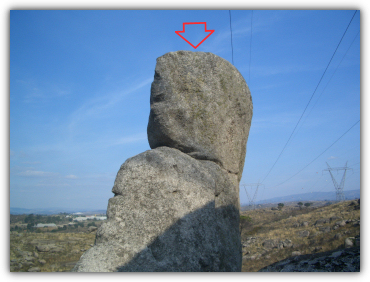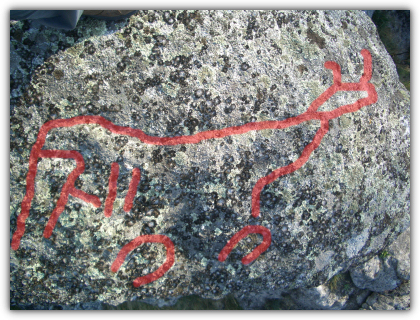|
Cavalo
Pintado [Gouveia]

[PT] Esta
cache vai levá-lo à penha do “Cavalo Pintado”.
De facto não existe nenhum Cavalo “Pintado” mas sim a
figura de um Cervídeo gravado no topo de um afloramento rochoso em
baixo relevo. Foi dado a conhecer pelo Dr. José da Silva, e no ano
de 1994 foi publicado pela 1ª vez, um artigo sobre esta gravura na
revista de arqueologia da Universidade de Salamanca. A sua
cronologia precisa é difícil de determinar, mas por comparação com
outros locais da Península Ibérica pensa-se que esta gravura se
integre no Epipaleolítico.
O difícil acesso à
gravura, só possível através de uns sulcos existentes nos lados do
rochedo (possivelmente feitos por mão humana), sugere que o penedo
pudesse ter tido um carácter de Santuário Rupestre.
Aquilo que se vê no
topo da rocha é a gravura de um quadrúpede de 125cm de comprimento
e 81cm de largura. As partes mais bem conservadas são a cabeça e o
dorso do animal. A cabeça tem dois apêndices que se assemelham às
orelhas do animal. Nos quartos traseiros identifica-se uma cauda, e
por baixo do conjunto, duas ferraduras. A análise do traço do
“Cavalo Pintado” sugere que tenha sido gravado por duas
fases: Primeiro a figura terá sido delineado por percussão
(pequenas covinhas), procedendo-se de seguida à abrasão dos traços
pré-definidos criando um sulco mais profundo.
A figura zoomorfa está
localizada no topo de uma rocha granítica de 2,60m de comprido por
1,35m de largura e apesar da erosão do cume da rocha, encontra-se
em muito bom estado de conservação.

(Localização do "Cavalo
Pintado")
|
 AVISO AVISO
Alertam-se todos os visitantes que, devido à natureza deste
local, existe o perigo de quedas, não me responsabilizando por
qualquer acidente. Aconselho o máximo cuidado.
|
Após este aviso, alerto que
a cache está perfeitamente acessível, não sendo necessário qualquer
escalada, ou colocarem-se em situações de perigo.
O mesmo não acontece
se quiserem ver de perto o “Cavalo Pintado”. Não é
impossível aceder ao topo do rochedo, usando os entalhes na
rocha, mas é necessário muita destreza, não ter vertigens e
muito, muito, muito cuidado. Não o tentem fazer com a rocha
molhada, sem calçado aderente e sobretudo se estiverem sozinhos.
Uma ajuda: na última parte da escalada, encaixem a mão
direita num entalhe da rocha no topo e coloquem o pé direito no 1º
entalhe, balançando-se um pouco para a esquerda… e depois
estão por vossa conta.
Não é impossível, mas
é muito difícil, se não se sentirem à vontade com alturas não
arrisquem. A segurança acima de tudo. Se puderem e quiserem
podem sempre levar uma escada, ou lerem atentamente o placar
informativo existente no local.
Como
chegar:
A pé (de preferência),
de bicicleta ou em viaturas TT.
Se estiver habituado a
transformar o seu citadino em TT, é possível, mas devido à
vegetação em alguns locais estreitos, não se livrará de uns riscos
na pintura, para não falar em outros obstáculos para viaturas mais
baixas (não aconselhado).
Partindo do local
apontado como Park (WP1), tome o caminho (WP2) indicado e siga as
instruções abaixo. São cerca de 2Kms para cada lado.

[EN] This
cache will take you to the “Painted Horse” rock.
In fact there is no Horse "Painted" but the figure of a Deer
engraved on top of a rocky outcrop. Was reported by Dr. José da
Silva, and in 1994 was published for the first time, an article
about this engraving in the journal of Archaeology at the
University of Salamanca. Its chronology is difficult to determine,
but by comparison with others in the Iberian Peninsula it is
thought that this engraving integrates in Epipaleolithic. The
difficult access to engraving, only possible through existing
grooves in the side of the rock (possibly made by human hand),
suggests that the rock could have had a Cave Shrine. What you see
at the top of the rock is the engraving of a zoomorphic figure of
125cm-length and 81cm-large. The parties best-preserved are the
head and the back of the animal. The head has two appendices which
resemble ears. In the hindquarters identifies a tail, and below the
set, two horseshoes. Analysis of trace of "Painted Horse" suggests
that has been written by two phases: the first figure has been
delineated by percussion (small existing dimples), then abrasion of
dashes pre-defined creating a deeper Groove. The Figure is located
at the top of a granitic rock with 2,6m long by 1,35m wide and
despite the erosion of rock Ridge, is in very good
condition.
|
 WARNING WARNING
Due to the nature of this site, there is the danger of crashes,
not blaming me for any accident. Advise the utmost
care.
|
After this warning, I would
say that the cache is perfectly accessible, and you do not need any
climbing, or put yourself in danger.
The same is not true
if you want to see closely the “Painted Horse”. It
is not impossible to access the top of the rock, using the
notches on the rock, but need to have a lot of dexterity, do not
have vertigo and be very, very, very careful. Don't try to do
it with the wet rock, without footwear adherent, and especially if
you are alone. A Little help: in the latter part of
climbing, snap the right hand in a notch at the top of the rock and
place the right foot in the first slot, rocking slightly to the
left ... and after you are by your own.
It is not impossible,
but it is very difficult, if you don’t feel comfortable, do
not try. Safety above all. If possible, bring a ladder, or
read carefully the information locally placed.
How to
reach:
By foot (preferably),
bicycle or TT vehicles.
If you're used to
transform your city in TT, is possible, but due to vegetation in
some narrow locations, you may gain a few scratches in the
painting, not to mention other obstacles to lower cars (not
advised).
Starting from the
location pointed to as Park (WP1), take the path (WP2) indicated
and follow the instructions below. The length of the path is around
2Kms for each side.

(Isto foi o que eu vi, no topo do penedo ("Pintei" a vermelho,
digitalmente))
Panorâmica 360º Panoramic
Textos retirados e compilados de:
Junta de
freguesia de Arcozelo da Serra e
Universidade
de la Rioja (trabalho de Carmen Dolores Franco
González).
Conteúdo inicial:
Boneca, berlinde, boneco "Gaspar", Porco e Carrinho
miniatura
|